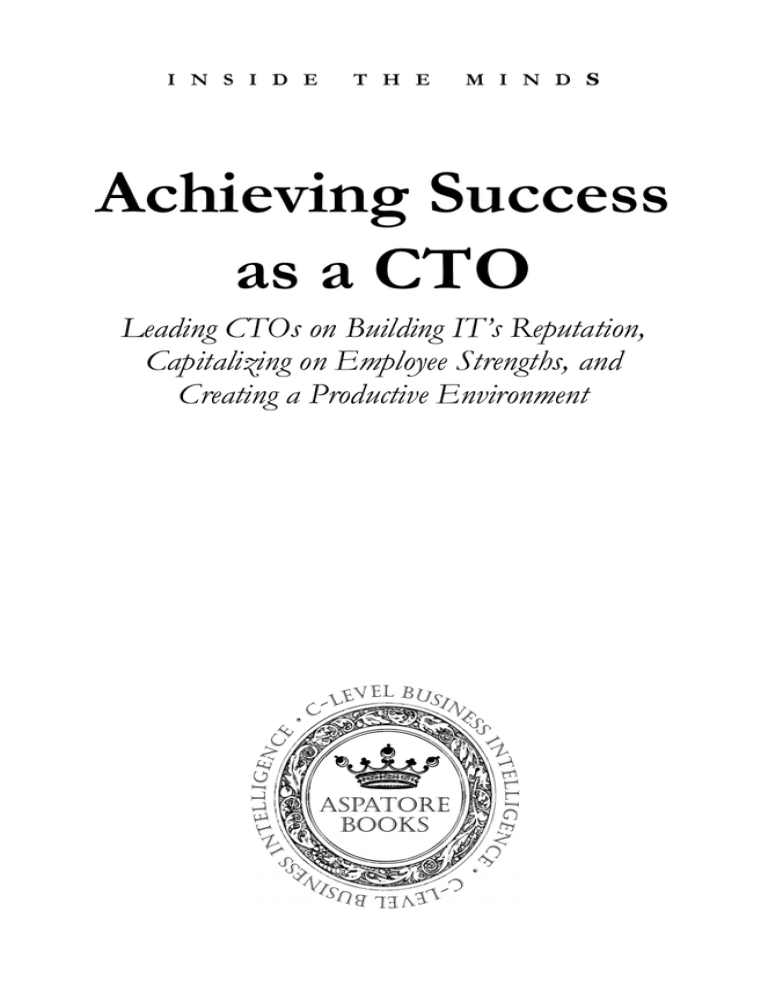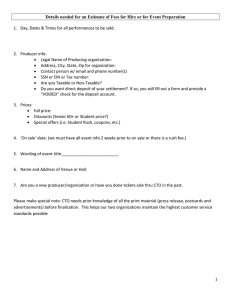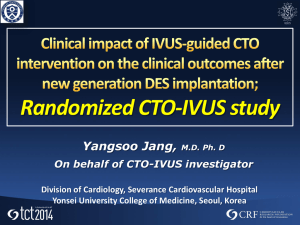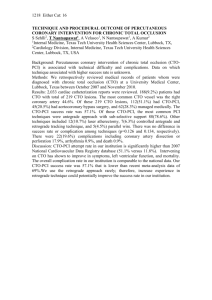
I N S I D E
T H E
M I N D S
Achieving Success
as a CTO
Leading CTOs on Building IT’s Reputation,
Capitalizing on Employee Strengths, and
Creating a Productive Environment
©2008 Thomson/Aspatore
All rights reserved. Printed in the United States of America.
No part of this publication may be reproduced or distributed in any form or by any means, or stored in
a database or retrieval system, except as permitted under Sections 107 or 108 of the U.S. Copyright Act,
without prior written permission of the publisher. This book is printed on acid free paper.
Material in this book is for educational purposes only. This book is sold with the understanding that
neither any of the authors or the publisher is engaged in rendering legal, accounting, investment, or any
other professional service. Neither the publisher nor the authors assume any liability for any errors or
omissions or for how this book or its contents are used or interpreted or for any consequences resulting
directly or indirectly from the use of this book. For legal advice or any other, please consult your
personal lawyer or the appropriate professional.
The views expressed by the individuals in this book (or the individuals on the cover) do not necessarily
reflect the views shared by the companies they are employed by (or the companies mentioned in this
book). The employment status and affiliations of authors with the companies referenced are subject to
change.
Aspatore books may be purchased for educational, business, or sales promotional use. For information,
please email West.customer.service@thomson.com.
ISBN 978-0-314-97975-9
Library of Congress Control Number: 2007943633
For corrections, updates, comments or any other inquiries please email
TLR.AspatoreEditorial@thomson.com.
First Printing, 2008
10 9 8 7 6 5 4 3 2 1
If you are interested in purchasing the book this chapter was originally included in,
please visit www.Aspatore.com.
The Role of the CTO in
a Technology Company
Steve Hart
Co-Founder and Chief Technical Officer
ViaSat Inc.
Inside the Minds – Published by Aspatore Books
Necessary Traits of a CTO
There are many criteria for being a CTO. The first and most important is a
love of technology. I saw my first computer in 1971. It was programmed to
play tic-tac-toe and make rude remarks during the game. When I realized
that someone had programmed it that way, I fell in love. I wanted to own
my own computers and make them jump through hoops of my own
devising. My degree is in mathematics, not engineering, and I love working
with computers. I feel that computer programming is one of the most
elegant and demanding forms of applied mathematics. A love of learning is
also necessary for working in this field. I read everything I can get my hands
on such as technical books, trade magazines, technical journals, and
anything useful on the Internet. I have worked in a wide variety of positions
within the technology world, and when I am able to find spare time, I enjoy
trying out new tools, programming languages, and environments. A CTO
must also possess the ability to think effectively in abstract terms, the ability
to deal with ambiguity, and strong leadership and team-building skills since
long-term success requires accomplishing far more than one person can do
alone.
A Successful CTO
The only true way to measure the success of a CTO is to look at the success
of the enterprise. A CTO is successful if he or she effectively supports and
enables the business of the company. The way to do that is to understand
how technology is going to impact the business. The CTO can measure
effectiveness using the same metrics that are used to measure the business.
In my case, that is defined as sustained growth while maximizing return on
invested capital. It may seem counterintuitive that a CTO would use the
same measures of success as that of a CEO, but unless you can understand
directly how your technology decisions impact the business, there is no way
that you can know that those decisions are the right ones. Of course, the
tools that the CTO uses to drive that business success are technical ones.
These include technical expertise, technology leadership, and use of
information technology for strategic gain.
All CTOs need to have credibility as technology leaders. They must be
credible in the eyes of the other corporate leaders, the employees, and the
The Role of a CTO in a Technology Company – By Steve Hart
customers. A CTO must understand how IT drives the company and
understand the context of the technology in terms of other technical areas,
the customer’s needs, the business impact, and the corporate strategy. The
challenge is not just to understand these issues, but to be able to
communicate them in terms that apply to the interested parties. The most
important issue to a development engineer may be quite different from the
most important issue to a customer, but each should understand the impact
of their issues in the larger context.
Evolution of CTO
The role of CTO has grown to become more of a true C-level executive. In
a public company, shareholder value must always be at the forefront of
decisions, and the CTO has to understand this in all of its facets. Now, IT
must be used to gain strategic advantage for the company, and the role of
technology cannot be downplayed. The role will continue to evolve as the
line between internal technology and external technology continues to blur.
At ViaSat, we are moving more toward development and integration of
whole systems, and there is a lot of overlap between what we do for our
customers and what we do for our enterprise. I cannot directly influence
every project, but I can help identify the strategic value of our technology.
If I know that a particular technology will help the company make money
and give us an unfair advantage in our market, I will bring that technology
to the attention of the executive team. I am as much a chief innovation
officer as I am a chief technology officer. I must champion innovative ideas
and make sure that our employees are set up to be innovators.
CTO Challenges
There are many challenges that a CTO must face on an almost daily basis.
The first is keeping up with technology. The rate of change is fast and
accelerating. In order to stay ahead, you have to understand the business in
which you operate. When you understand the business and its needs, you
are better able to communicate solutions to both the IT team and the
business leaders. This can be a difficult area for CTOs as we come from
technical backgrounds and frequently have little interest in business
management. Credibility is also incredibly important. The people you work
Inside the Minds – Published by Aspatore Books
with must value your judgment and leadership. Honesty and integrity are
important stepping stones to building credibility.
Another challenge is finding the right balance of breadth versus depth.
There will always be more technology than a single person can understand.
In some cases more depth is required; for example, understanding the
underlying mathematical principles involved in network queuing or data
compression. In other cases breadth is more important; for example,
understanding the full range of issues involved in creating the proper
enterprise architecture. At my organization, we have a very technical
leadership team, including two distinct CTO positions. I focus on
networking, security, software, and IT. The other CTO, Mark Miller,
focuses on communication theory, RF, and hardware. In addition our CEO,
Mark Dankberg, is extremely technically proficient and works to drive our
technical strategy. While Mark Dankberg is the master of strategic thinking,
my expertise is in problem solving. This combination works very well.
Intellectual property is yet another challenge that CTOs face. The world of
intellectual properties is dotted with land mines. It is important to watch
your step in creating technology. You must create IP that is directly
valuable, as well as build a strong portfolio of IP for your own defense.
Overcoming Challenges
The biggest challenge I have faced as a CTO is dealing with growth. This
company was created by three people. Our imaginations initially only took
us so far; far enough to see how we could become a $10 million company.
Now we earn over $500 million per year in sales and employ a staff of over
1500, including over 700 engineering and IT people. A primary way that I
was able to deal with our growth was through a concerted effort to develop
internal leadership. We created a formal “people development” program.
This has allowed us to create a team of business and functional leaders who
have the capability to carry forward the strong culture of growth,
technology leadership, and personal integrity that are the hallmarks of our
company.
The integration of acquisitions has been part of our growth. Our approach
is not to become a portfolio or holding company, but to gain strategic
The Role of a CTO in a Technology Company – By Steve Hart
advantage through integration. The difficulty lies in the balance of letting
the acquired company retain what made it special in the first place while
bringing the common cultural and business advantages of being a part of
our company. We do this by developing strong working relationships with
the leaders of the acquired companies. Personally, I work hard to
understand the new technology and to develop a good relationship with the
technology leaders of each newly acquired company.
Personal Management Style
I enjoy working with people. I surround myself with very smart people of
high integrity. I show interest in them and their needs. In return, I am able
to make friends and gather a group of people who are willing to listen to my
ideas and take direction when necessary. It isn’t necessary to be likeable to
lead people, but it certainly helps.
My management style is quite informal. I have spent my entire career trying
to avoid being managed and I assume that most technical people don’t want
to be managed either. I reserve management for business units, projects,
and budgets. My leadership approach is to use influence with a team of
people to achieve the desired goals. This involves applying the right
leadership tool for the situation. You must be able to create a vision, and it
is important to set easily understandable goals. You must be able to
influence people, which, as a co-worker once memorably stated, “is the
ability to let other people have it your way.” You must be a good coach in
order to help your team succeed. When appropriate, you must delegate. It is
important to delegate end goals, not particular tasks: let smart people figure
out how to do it themselves. In many cases, the CTO must work outside of
the team to make sure obstacles are limited or removed. Finally, ownership
is a necessity. The CTO must be willing to make lonely decisions, to admit
to mistakes without taking credit for successes, and to deal with the full
range of business issues relating to IT, not just the fun technical ones.
Working with the Management Team
As we have grown, we have needed to develop a strong set of business
leaders. Our company president and I work closely on the key operational
issues. We also have a set of general managers, grown almost exclusively
Inside the Minds – Published by Aspatore Books
internally, that I work with to help support the specific business goals. We
share technology, people, and methodologies across the business units. I
also work very closely with the functional VPs of engineering, IT, finance,
operations, and HR. When we were smaller I directly ran both engineering
and IT. Now we have executives dedicated to those functions and I work
with them to help accomplish all of our technology goals.
Working Style of IT
At ViaSat, technology consists of both engineering, which encompasses
product development, and IT, which includes internal projects and support.
We have a separate vice president of engineering and vice president of IT
with oversight over those functions. The engineering side provides a
centralized source for standards, support functions, technology initiatives,
and engineering career development. The actual engineering projects are
decentralized as each engineer works on projects within their business area.
IT, on the other hand, is fully centralized. The management structure is
centralized and organized by function. The support functions, service
functions, infrastructure, and projects are team-oriented.
Working Style of Organization
During my career, I have experienced pure matrix organizations and pure
line organizations and have run into problems with both. We have created a
hybrid of the two. We have a central organization that supports
collaboration, shared knowledge across the business functions, and process
improvements, but we distribute the actual project functions to make sure
they address the immediate business goals of each business unit. This
eliminates conflict of interest and replaces it with total accountability.
Building the Reputation of IT
It is challenging to build the reputation of IT in an engineering
organization. Engineers tend to be the hardest customers to please. In the
past we struggled in this area, but have achieved good success in recent
years, partly due to bringing in some very strong leadership. Our vice
president of IT is not only a strong IT leader, but he also has an engineering
background. He has successfully reached out to the business units to
The Role of a CTO in a Technology Company – By Steve Hart
understand their needs and better align IT to support them. In addition, we
have continued to upgrade capabilities of the IT staff through a
combination of continuing education of existing staff and hiring additional
top professionals.
Securing Funding
Our business units are responsible for securing funding for engineering
projects and product developments activities. This is through a
combination of customer-funded activities and internal R&D funds. For
internal projects, we have a standard budget for accomplishing smaller
projects. But for any major project, we require a detailed ROI (return on
investment) analysis. As a growing profitable company we are able to fund
the projects, but it is important to select projects that are of greatest value
to the corporation. For example, time to market is a key driver in our
profitability, and a project that improves time to market may provide much
more value than one that improves the efficiency of a functional team.
Managing Technology Teams
We form teams on a project basis. Each project can have a completely
different structure, but all must follow standard processes, including
progress tracking and peer reviews. We let the project structure lead the
nature of the work. Since teams are temporary, we can move people around
as necessary to keep a highly dynamic environment and assist people in
their career development. When challenges arise, I may step in to provide
an alternative view or bring in additional resources. Sometimes, if a team is
finding a problem too difficult, they may be trying to solve the wrong
problem.
Establishing Goals
We have formal goals at the top level of each division. The details and
specific projects are not established by me as the CTO. Instead they are
established by the unit with fiscal responsibility for that project. I try to
make sure that the goals are consistent with the corporate and business
goals. The projects must never be implemented for departmental gain only,
because that hurts the overall mission of the organization.
Inside the Minds – Published by Aspatore Books
Measuring Success
Our standard project review process includes major gate reviews and minor
subgate reviews, as well as monthly program management reviews, and
earned value reporting when appropriate. Success is defined on a projectby-project basis. Before a project begins, success criteria are defined. These
criteria are adapted as necessary during the project. For the support teams,
success is based on standard metrics compared to industry benchmarks.
Capitalizing on Strengths
We like to set up every employee so that they can succeed in achieving both
company goals and their own individual career goals. We work in an
extremely demanding environment. Everyone must contribute at a high
level and have the capacity to grow either in their work ability or their scope
of interest. If issues arise where people’s career goals are not consistent with
their capabilities, then we have to identify those problems and deal with
them. It is a mutual effort to get the most out of the employee and to help
the employee get the most out of the company.
Creating a Productive Environment
My goal is to create a positive and productive environment in which I enjoy
working, and would have enjoyed working in when I was a software engineer.
We try to hire the highest quality people who are also consistent with our
corporate culture. We value integrity and we provide whatever tools necessary
to get the job done. In this environment, we make sure that everyone
understands the vision of the company and their part in achieving that
mission. In fact, it is easy to motivate people to do their best if you provide a
good work environment in the form of both people and facilities. You must
also provide competitive compensation and benefits. Successes must be
celebrated and problems must be listened to with your full attention.
These are only a few thoughts about achieving success as a CTO. Total
success still requires a bit of luck combined with adaptability to changing
conditions, the willingness to admit that you don’t know, and the
commitment to let other people do things better than you could do them
yourself.
The Role of a CTO in a Technology Company – By Steve Hart
Steve Hart is CTO and co-founder of ViaSat Inc. He provides technical direction across
the company in areas of networking, architectures, software technology, and information
security. He works with ViaSat’s diverse set of business areas to drive innovation and
strategic positioning. He also supports business development activities, with technical
support in product concept development, customer relations, and proposal activities. Mr.
Hart has authored numerous technical papers in satellite networking and computer and
communications security, and holds patents for inventions in these areas. He contributed
to the growth of ViaSat from three people in 1986 to an international company with over
1500 employees today.
Mr. Hart has provided leadership in many of ViaSat’s products, helping the growth from
individual “black-box” products to fully integrated network communications systems. He
led in the development of new satellite networking algorithms and directed the creation of
ViaSat's Information Security business.
Prior to joining ViaSat, Mr. Hart was a staff engineer and engineering manager at
Linkabit Corporation. Prior to that, Mr. Hart worked as a computer security analyst at
the Merdan group (both located in San Diego, California) on various projects for the
National Security Agency and the Navy. He served U.S. Air Force as an imagery
intelligence specialist for four years.
Mr. Hart holds a M.A. in mathematics from the University of California, San Diego,
and a B.S. in mathematics from the University of Nevada, Las Vegas.
Dedication: To my wife, Sue; my partners, Mark Dankberg and Mark Miller; and
all of the wonderful employees of ViaSat.
www.Aspatore.com
Aspatore Books is the largest and most exclusive publisher of C-Level
executives (CEO, CFO, CTO, CMO, Partner) from the world's most
respected companies and law firms. Aspatore annually publishes a select
group of C-Level executives from the Global 1,000, top 250 law firms
(Partners & Chairs), and other leading companies of all sizes. C-Level
Business Intelligence™, as conceptualized and developed by Aspatore
Books, provides professionals of all levels with proven business
intelligence from industry insiders – direct and unfiltered insight from
those who know it best – as opposed to third-party accounts offered by
unknown authors and analysts. Aspatore Books is committed to
publishing an innovative line of business and legal books, those which
lay forth principles and offer insights that when employed, can have a
direct financial impact on the reader's business objectives, whatever they
may be. In essence, Aspatore publishes critical tools – need-to-read as
opposed to nice-to-read books – for all business professionals.
Inside the Minds
The critically acclaimed Inside the Minds series provides readers of all
levels with proven business intelligence from C-Level executives (CEO,
CFO, CTO, CMO, Partner) from the world's most respected companies.
Each chapter is comparable to a white paper or essay and is a futureoriented look at where an industry/profession/topic is heading and the
most important issues for future success. Each author has been carefully
chosen through an exhaustive selection process by the Inside the Minds
editorial board to write a chapter for this book. Inside the Minds was
conceived in order to give readers actual insights into the leading minds
of business executives worldwide. Because so few books or other
publications are actually written by executives in industry, Inside the
Minds presents an unprecedented look at various industries and
professions never before available.




